|
From a wayfarer’s sketchbook
By Anne Walker
The author is a self-taught artist whose interest in painting was inspired by her time in Aden and the opportunities which came her way to travel up-country.
| |
|
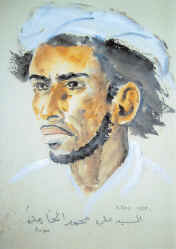 |
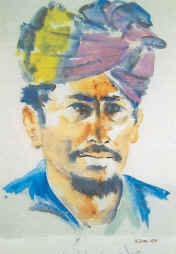 |
| |
|
Sayyid Ali
Muhammad al-Hamed,
Dhala’. |
Yahya Hussain
‘Atif al-Yafa’i,
Lahej. |
I lived in Aden from 1955 to 1967, where I was married to Brian Doe, the Chief Architect and, later, Director of Antiquities. During this time I was able to accompany him on some of his trips inland. I went several times to Abyan and Zinjibar; the main highway was along the Khormaksar beach, and one had to be wary of the incoming tides. Lahej was also a day trip from Aden, and I think it was there that I met and drew Yahya Hussain Ali, a dignified Yafa’i tribesman.
During these visits I started to draw and paint our escorting guards and sometimes the townsfolk as well. I was learning Arabic with Christiane Besse, our tutor being Hamza Luqman whose family published The Aden Gazette. This enabled me to do voluntary work among Arab women in the maternity unit in Crater. The suq there offered many fascinating subjects to draw, as did the dhow repair and shipbuilding yards on Slave Island. Best of all were the trips which I was able to make up-country. I was invited by Peter and Archie Hinchcliffe to visit them in Dhala and was lucky enough to be taken up in a helicopter. The Amir’s palace perched on the top of the hill overlooking the town made a good focal point for a painting. While sketching in the suq below, I approached a bystander and asked if I could paint his portrait. I offered a small remuneration and he agreed. I got him to sign his name – Sayyid Ali Muhammad al-Hamed – at the bottom of the portrait, and later discovered that he was from the Da’ari tribe, many of whom were considered ‘dissidents’. It was then that I decided to try to paint portraits wherever I went, often having to sit on the ground while my subject sat cross- legged in front of me.
I also visited Beihan at the request of the military to do some drawings for them, and was again taken up by helicopter. My husband had asked me to take a message to the renowned Sharif of Beihan about a certain copper bowl in the Aden Museum. I was invited to take tea with him – an unusual honour for a European woman – and found him charming. What a splendid portrait he would have made if only I had had the courage to seek his permission! While in Beihan I noticed the smart and handsome figure of a young soldier from the Federal National Guard and asked him if I could paint his portrait. He was surprised, and possibly a little flattered, but he agreed. He declined my offer of a small fee.
| |
|
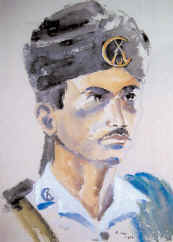 |
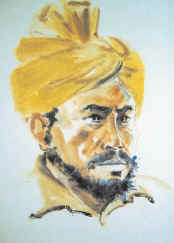 |
| |
|
Federal National
Guardsman,
Beihan. |
Sa’id Muhammad
Muhsin
from Habban. |
Another time I flew up to Wahidi State with a friend, Joan Duirs, whose husband piloted the Aden Airways Dakota in which we travelled. He allowed us into his cockpit as we flew up to Maifa’ah, the Wahidi capital, where we stayed in the house of the absent Agricultural Officer. A few days later Joan had to return to Aden and I was left to paint by myself. My Arabic was quite enough get by in all the places I visited, and as a woman I always felt safe. I went down to the suq in Maifa’ah to explore and to do some drawing, and incurred the displeasure of the local political officer, Hugh Walker, for not telling him where I was going!
Wherever I went I was greeted with courtesy and curiosity, and surrounded by a mass of people when I sat down to paint. Some of the bystanders were only too willing to be models for a small fee. I even heard myself described as ‘al-nasraniya al-majnuna’, ‘the mad European woman’; my reputation had preceded me!
Men from the surrounding tribes in Wahidi used to come into Maifa’ah to see the Sultan, the State Secretary or the political officer. I noticed one man with a striking yellow turban, and learnt that his name was Sa’id Muhammad Muhsin, who hailed from the town of Habban. I asked him if I could draw him, and he graciously agreed.
Perhaps the most memorable of my painting excursions was my visit to Hadhramaut. Mukalla, on the coast, was most picturesque but the area which I particularly wanted to visit was Wadi Hadhramaut. Fortunately I was able to fly up to Tarim where I stayed in the comfortable Al-Kaff Guest House. I was able to visit Seiyun with its beautiful palace and mosques, and Shibam with its mud skyscrapers.
When the time came to return to Mukalla, instead of flying, I had to go by road. The only vehicle available at the time was a lorry carrying sand, and the only space available was on top of the sand in the back of the lorry, which I shared with an ‘indigo’ bedouin! Our driver was a very young man who drove the old lorry at a frightening speed, and we careered round many a hairpin bend in the mountains behind Mukalla. At a rest stop I was able to persuade my bedouin companion to let me paint his portrait, whereupon several other bedouin appeared from nowhere and offered to sit for me. But we had to move on. What fun it all was!
| |
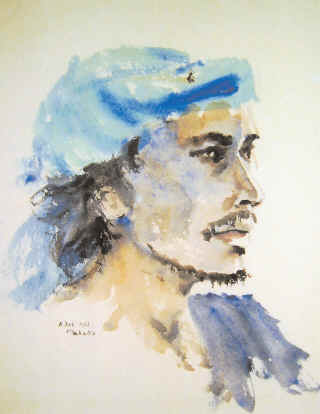 |
| |
| The ‘indigo
bedouin’ who accompanied the author to Mukalla. |
(For limited edition ‘giclee’ colour prints of the portraits illustrated above, email:
hughwalker@talktalk.net)
Vol
15. 2007
|
